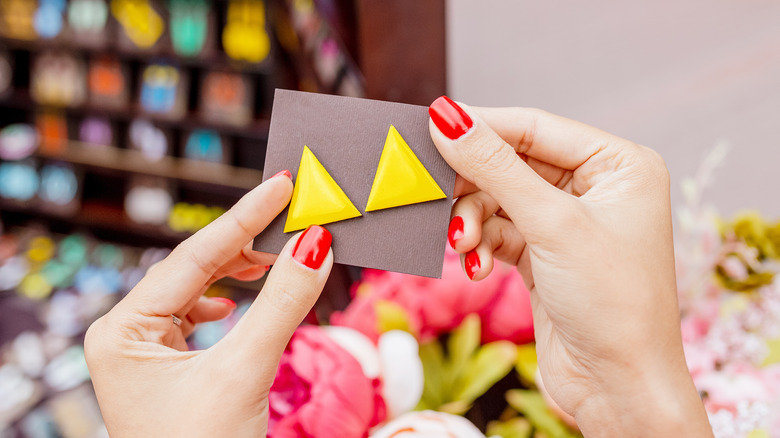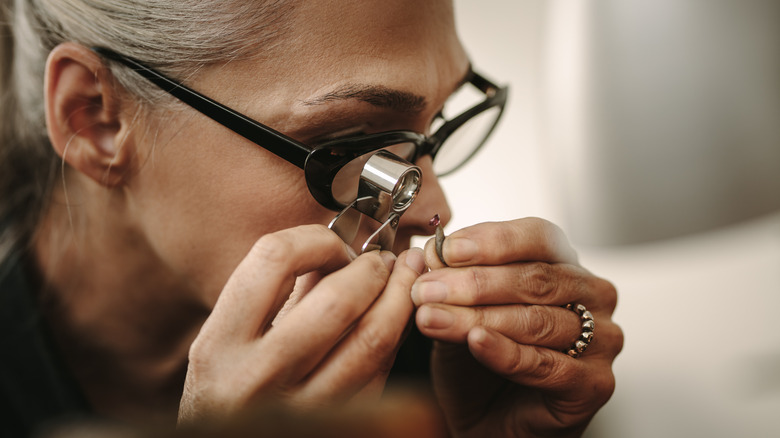The Scientific Reason Some Jewelry Turns Your Skin Green
Trivia heads and history buffs alike enjoy dropping knowledge about how the Statue of Liberty didn't always have that green color we associate with it today. But did you know that the reason some jewelry tints your skin green is the same reason the Statue of Liberty has that pale emerald hue? Next time your finger changes colors from a ring you're wearing, no need to worry! It's not some rare disease that requires amputation — it's simply because of a non-harmful chemical reaction.
According to Refinery29, the reason your skin can change colors when wearing a certain type of jewelry is because the acids in your skin cause the metal in the jewelry, most often copper, to corrode. This reaction can also occur when silver or sterling silver (which is a combination of silver and either zinc or copper) comes in contact with your skin and oxidizes, leaving a darker stain where it sits on your body. Oxidation is a natural, often reversible, process that occurs when many different types of metals are exposed to environmental factors.
Unfortunately, this typically happens with modestly priced (read: cheap) jewelry. This is because these types of jewelry are often made of more affordable, yet sensitive metals such as aluminum, copper, brass, iron, nickel, and titanium. When these metals (or a mixture of them) combine with the sweat, lotion, and/or water, they begin to corrode, creating green salts which end up dyeing your skin (per How Stuff Works).
Know what's in your jewelry
While the type and cost of jewelry you buy is ultimately up to you, it's important to understand how to know what you're buying before you make the investment. Just like it's important to know the ingredients that are in the food you eat, it's also important to know the ingredients that are in the jewelry you buy — especially if you're someone who could be potentially allergic to certain metals. Unfortunately, it's not as easy as reading the label, but there are some tips that can come in handy when it comes to figuring out information about your jewelry.
Anything that's vermeil or "plated" as in gold-plated, means there is an underlying, usually more sturdy or cost-efficient metal beneath the layer of gold. While this is a good option for someone who is looking for more affordable jewelry to add to their accessories, it's important to note that gold-plated items are susceptible to tarnishing, wearing off, or chipping. Because of this, it's not recommended you wear gold jewelry when doing high-impact or water-based activities. Once the gold wears off and reveals the metal underneath, the green-skin-curse is bound to come back.
Tips to avoid dyeing your skin green
Most jewelers are required by the Federal Trade Commission to "truthfully represent the type, kind, grade, quality, quantity, metallic content, size, weight ... durability ... and distribution of their merchandise." It should be easy to find out any of this information when you're looking to buy a piece of jewelry. If you don't have access to the individual who made the jewelry, there might be clues on the pieces themselves. According to Worth, most fine jewelry features a stamp that reveals more information about what the piece is made of. For example, a 24K stamp means the ring is made of 24-carats or 100% gold. While this measurement system isn't exactly intuitive, there are plenty of guides that help decipher what these stamps mean.
However, not everyone can afford fine jewelry — and some people just want some fun, cheap things to wear on a night out. If this is the case, there are a couple of things you can do to keep your skin from turning green (via Business Insider). One is making sure not to get the jewelry wet or covered in lotion — necklaces and earrings are easier than rings when it comes to this task. The other option is to add a clear coat of nail polish to work as a sealant, this is an affordable way to get yourself a bit more durability with the pieces. Remember, if you do slip up and Hulk-out, it's easy to wash off.


